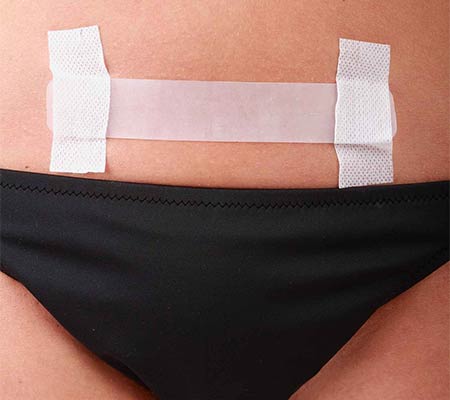Scar Types and Treatments

 Development of ReJuveness scar treatment products began when it was discovered that the application of silicone caused a dramatic change in the raised, abnormal, discolored scars known as keloids. In the 20 years since, ReJuveness has pioneered the treatment of a wide range of scars and skin conditions with the highest-quality occlusive silicone sheeting and barrier repair cream. Read on to find your type of scar and the most effective strategy for improving its appearance.
Development of ReJuveness scar treatment products began when it was discovered that the application of silicone caused a dramatic change in the raised, abnormal, discolored scars known as keloids. In the 20 years since, ReJuveness has pioneered the treatment of a wide range of scars and skin conditions with the highest-quality occlusive silicone sheeting and barrier repair cream. Read on to find your type of scar and the most effective strategy for improving its appearance.
Normal, abnormal, excessive and pathological scarring
Atrophic/Acne scars
- appear as a sunken area on the skin
- often look pitted
- in most cases are caused by collagen destruction from inflammatory conditions such as acne or chickenpox, accidents, surgery or genetic disorders
- resolve with Rejuveness treatment in six weeks to six months
Recommended products
- ReJuveness original silicone sheeting
- Hyper-Heal Cream
- Derma needling with .2mm to induce remodeling
Keloid scars
- can arise from any assault to the skin, from minor insect bites to major surgery.
- can grow or spread for years, even decades.
- are often associated with an epigenetic mutation of CD36 analogue SR-B1 by a malaria parasite in family lineage.
- have recently become demystified as a chronic wound condition, rather than a post-scarring proliferation of collagen.
- appear as shiny, raised, dark purple or red tumor-like growths, accompanied by itching and pain.
- resolve with Rejuveness treatment in six weeks to six months, compared to an average of 15 years* without treatment.
Keloid scars are rubbery or fibrous growths that form when fibroblasts continue to multiply even after the wound is filled in. This can happen to anyone with any type of injury, but it is particularly common when injuries happen to young people – under 30 years of age – to pregnant women, or to people of African, Latino or Asian descent. Keloids can grow larger than the original injury and are often accompanied by pain, itching and sometimes, restriction of normal movement. Considered a benign tumor, a keloid is difficult to remove. Operating on them usually stimulates more scar tissue to form.
Recommended products
- ReJuveness original silicone sheeting
- Hyper-Heal Cream
- Tension reduction techniques through taping
- Derma needling with .2mm for older, hard-to-resolve keloids
Read more: The natural history and spontaneous resolution of keloid scars
Hypertrophic scars
- result from deep, dermal assaults in high skin tension areas such as shoulders, joints, neck and chest.
- can complicate with scar contraction.
- regress with time and do not spread.
- appear dark, pink, red and itchy.
- resolve with Rejuveness treatment in six to 12 weeks.
Hypertrophic scars are more common raised scars caused by deposits of excessive amounts of collagen that form at the sites of pimples, body piercings, cuts and burns that go deep into the layers of the dermis and express transforming growth factor beta (TGF-β). They occur in all racial groups, but do not grow beyond the boundaries of the original injury. Like keloids, they can also itch, and cause pain.
Recommended products
- ReJuveness original silicone sheeting
- Hyper-Heal Cream
- Tension reduction techniques through taping
- Derma needling with .2mm to 1.0mm
Stretch marks
- usually occur after weight gain or loss
- can happen at any age
- seldom improve with the use of moisturizers alone
Silicone sheeting - used alone or in conjunction with Hyper-Heal Cream's ceramides, cholesterol and essential fatty acids, can significantly reduce the visibility of strecth marks in as little as a week.
Recommended products
- ReJuveness original silicone sheeting
- Hyper-Heal Cream
- In some cases, derma needling to induce collagen production
Scar contractures and deep dermal scars
Fixed, rigid and contracted scars can form after a burn or skin graft surgery because of abnormal tissue responses. They are caused by a lingering of myofibroblasts - the cell type responsible for the initial closing of wounds in a purse-string manner.
Scar contractures can develop simultaneously with hypertrophic scars, and can cause both functional and cosmetic problems.
- ReJuveness original silicone sheeting
- Hyper-Heal Cream
- Tension reduction techniques through taping
Read more: The Use of Silicone Adhesives for Scar Reduction
Surface epidermal wounds and chronic wounds
As the understanding of the keloidal scar as a chronic wound condition has developed, it has become clear that silicone sheeting has applications in the resolution of wounds that are still healing or have fallen into an incomplete or dormant state of healing. Unlike gauze dressings, which can dry out and adhere to the wound bed or the skin around the wound, ReJuveness silicone sheeting provides a protective moisture barrier that can remain in place for a number of days without causing trauma to the surrounding skin.
A number of clinical studies have shown soft silicone dressings minimize pain on removal for pediatric patients, burn patients, heel ulcers and patients with radiation skin reactions. One study found that the use of silicone dressings improved patients’ quality of life by reducing pain on removal, reducing anxiety and speeding up the healing process. Occlusive dressings are thought to increase cell proliferation and activity by retaining an optimum level of wound exudate, which provide vital proteins and cytokines in response to the injury. These generate autolytic debridement of the wound to promote healing.
Recommended products
- ReJuveness original silicone sheeting
- Hyper-Heal Cream
- Tension reduction techniques through taping
The correct combination and application of ReJuveness® Heal Scars™ treatments can lead to near scar-less healing and near perfect skin.
